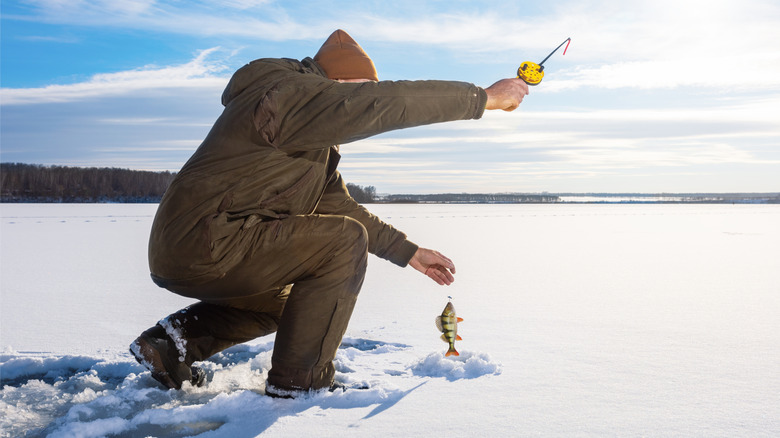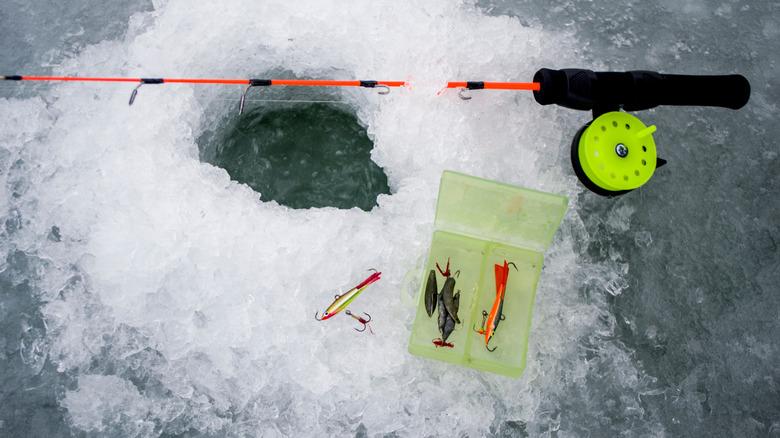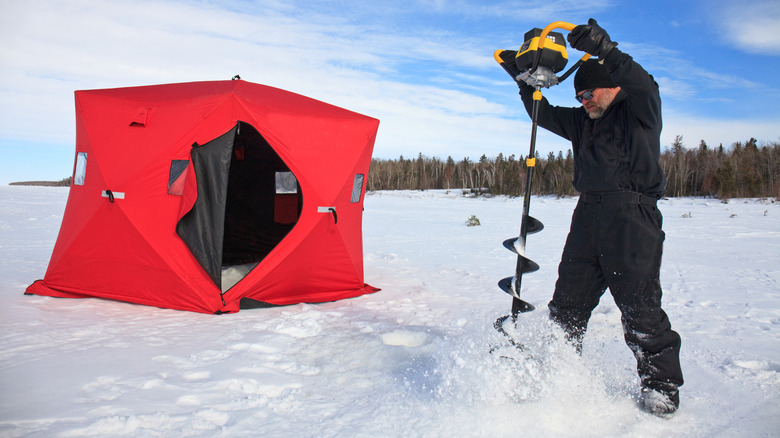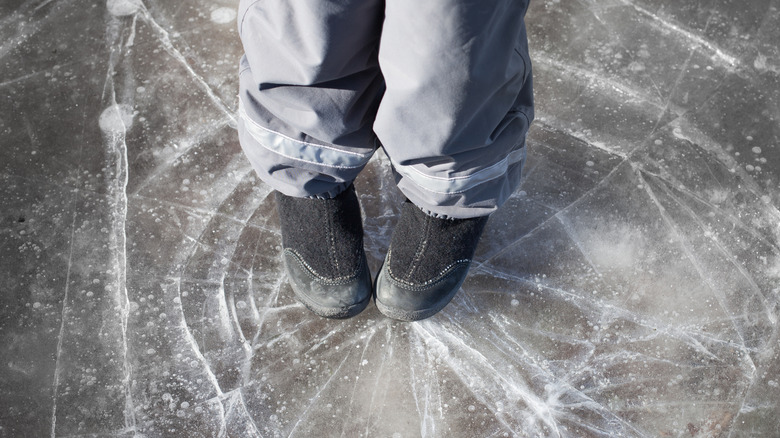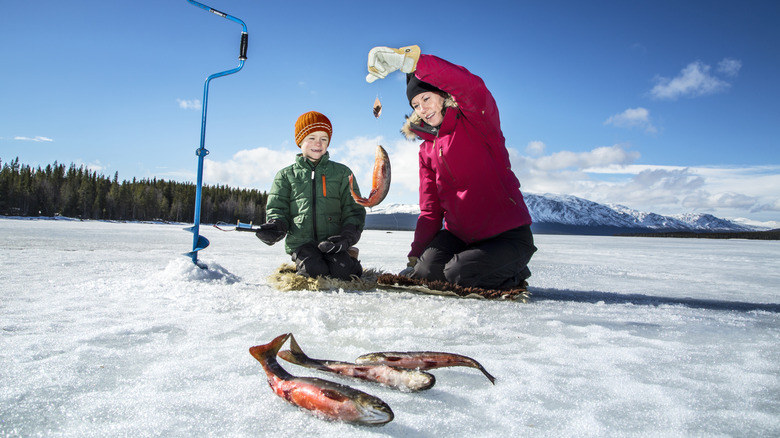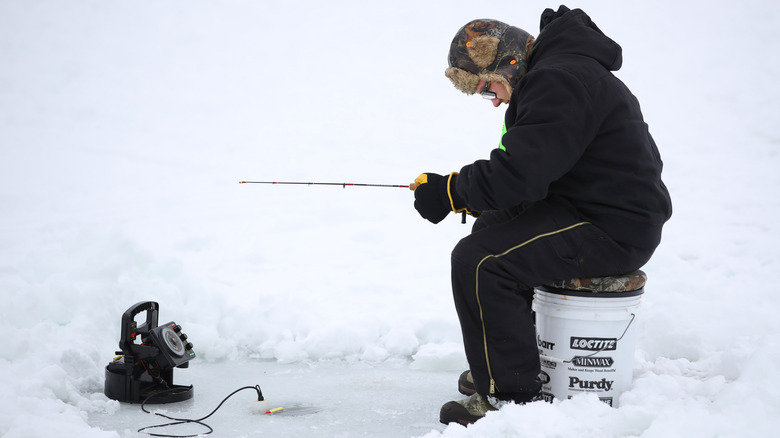A Beginner's Guide To Ice Fishing: Tips And What You Will Need
We may receive a commission on purchases made from links.
Once winter sets in, ponds and lakes throughout much of the northern region of the United States become covered with thick sheets of ice. This makes it a winter wonderland for those who enjoy ice skating, ice hockey, and other pursuits that require a frozen surface. However, this presents a conundrum for fishermen who need liquid, not solid, water to enjoy their sport. As is often the case, necessity led to the invention of a new form of angling — ice fishing — in order to get around this icy blockade.
Ice fishing actually began out of true necessity, as indigenous people in these cold regions needed a way to catch fish for food during the winter. A couple millennia later, recreational fishermen continue to use this method of cutting a hole in the ice in order to access the fish beneath. This form of fishing doesn't appeal to everyone, but there are dedicated enclaves of ice fishermen throughout Canada and much of the northern United States.
If you are wanting to get in on this icy angling action, there are a few things you need to know before you get started. This is because while ice fishing is, well, fishing, it requires much different tackle and technique than other types of angling. Additionally, there are safety concerns that come with fishing on the ice that don't occur with other forms of fishing. But, you can certainly have an enjoyable, productive, and safe outing on the ice if you are properly prepared and follow safety precautions.
Ice fishing tackle
Those new to ice fishing will notice a difference right away with the primary tool used by all anglers — the fishing rod, or pole. When fishing during other times of year, anglers in these areas will use rods ranging from five to 10 feet long. Ice fishing rods, however, are significantly shorter — typically only two to three feet, although slightly longer models are available. These rods are matched with a light spinning reel or ice fishing reel. Outfits such as the Shakespeare Ugly Stik GX2 Ice Fishing Reel & Rod Combo are good choices for a variety of ice fishing scenarios.
Some anglers opt for what are known as tip-up rigs as opposed to rod and reel outfits. Gadgets such as the Frabill Arctic Fire Tip-Up, are essentially hand line rigs with a built-in alert mechanism. Anglers utilizing tip-ups typically set out several within a relatively small area, wait for the flag to pop up, then fight the fish by hand.
Regardless of whether using a rod or tip-up, ice fishermen will also need a selection of lures and baits, as well as leader material, and terminal tackle such as hooks, bobbers, and sinkers. Generally, the same items that were considered the best freshwater baits during other portions of the year will work when ice fishing, assuming they are available. Artificial lures like jigs and spoons are also often used.
Equipment for ice fishing
Ice fishing also requires a few pieces of equipment that are very specific to the sport. That starts with the tool used for creating a hole in the ice, which is basically a portal to the frozen water beneath. To that end, an ice auger is an absolutely essential piece of equipment for ice fishing. Some anglers opt for basic hand-operated models, such as the Eskimo Hand Auger. Augers that attach to portable drills are also popular, while the most serious ice fishermen often invest in fully automated electric ice augers.
In addition to the auger, anglers will need an ice scoop to keep the hole free of small chunks of ice. A fish picker, which is similar to a small gaff, is handy for landing fish and pulling them through the ice hole. A bucket or cooler for bait or fish is needed as well.
Many fishermen also opt to bring along a chair to prevent having to kneel on the ice for long periods of time. Ice fishing tents, or shanties, like the Eskimo Quickfish Pop-Up Portable Ice Fishing Shelter can make long hours on the ice more comfortable, as can portable propane heaters. An ice sled can make it much easier to carry all this equipment across the ice.
Ice fishing safety
As with any outdoor pursuit, safety should be a priority when ice fishing. However, there are a few concerns that are unique to ice fishing, which absolutely need to be considered. The first of these is the ice itself. Drowning and hypothermia are two of the most common ways people die when fishing. Each of these is a definite threat while ice fishing.
It might seem impossible to drown when ice fishing. However, it happens more often than people realize, as it is quite possible to fall through the ice if it is not thick enough to hold your weight. In fact, CBS News reported that such an incident claimed the life of an ice fisherman in New York at the beginning of 2024. To ensure a safe trip, it is important to wait until the ice is at least four inches thick before venturing out on foot and at least five to seven inches deep before putting a snowmobile or ATV on it. Even with adequate thickness, be sure to frequently check as you move along using an axe, chisel, spud, or auger, as ice can vary in thickness throughout an area.
To ward off hypothermia, it is important to dress for a winter adventure, which means wearing layers of warm clothes. Additionally, be sure to wear waterproof boots, pants, and jackets, as well as gloves and ice cleats. Be sure to never venture onto the ice alone, wear a life jacket, and always carry a length of rope and safety whistle.
Locating a good spot
Finding a good spot for ice fishing involves more than just finding an area where the ice is thick enough for safety purposes. When ice forms on the lake's surface, the fish will still be related to the structure in the water beneath it. Early in the ice fishing season, the fish are usually in the same spots they were immediately prior to the ice forming. Later in the season, they tend to move into deeper water and will be concentrated around structures there.
With that in mind, anglers can mark these spots throughout the year, then use a handheld GPS unit like the Garmin eTrex to locate them once the surface freezes over. Portable fish finders, such as the Garmin Striker 4, incorporate GPS to help find previously marked spots with fish finder capabilities that can be utilized once a hole has been dug in the ice.
Once you've made your way to a likely spot, making a hole in ice involves placing the tip of the auger on the ice then either turning the handle or turning on the motor, depending on the model of auger you have, and drilling until you have gone completely through the sheet of ice at the surface. Some anglers enlarge the hole with a chainsaw. Once the hole is dug, it is important to keep it ice-free with an ice scoop throughout your fishing session.
Ice fishing techniques
Generally speaking, ice fishing techniques are relatively simple. The two main techniques are jigging and using tip-up rigs. It is important to keep in mind that when the water is cold, the fish will be more lethargic. This means they will move more slowly and the bite will be more subtle. As a result, using light line and sensitive rods will help while jigging. Likewise, having a light setting on the tip-up rig will help you not miss subtle strikes.
Jigging involves dropping a lure or bait into the hole with an ice fishing rod and reel. Ideally, the bait should be at the same depth or slightly above the depth the fish are at. A portable fish finder can be helpful with this. Then, the lure or bait is slowly lifted and dropped. Some anglers choose to use a light bobber to help them detect subtle strikes.
With a tip-up rig, the bait is lowered to the desired depth, where it will remain suspended until a fish strikes. When a fish does take the bait, the flag pops up to alert the angler, who then pulls the line in by hand. Most tip-up fishermen drill multiple holes and set out numerous rigs at once. Just be careful not to drill too many holes too close together and weaken the ice. Additionally, even if you don't see a flag go up, you should check your tip-up jigs at least every 30 minutes to ensure a fish didn't take the bait without tripping the flag.
